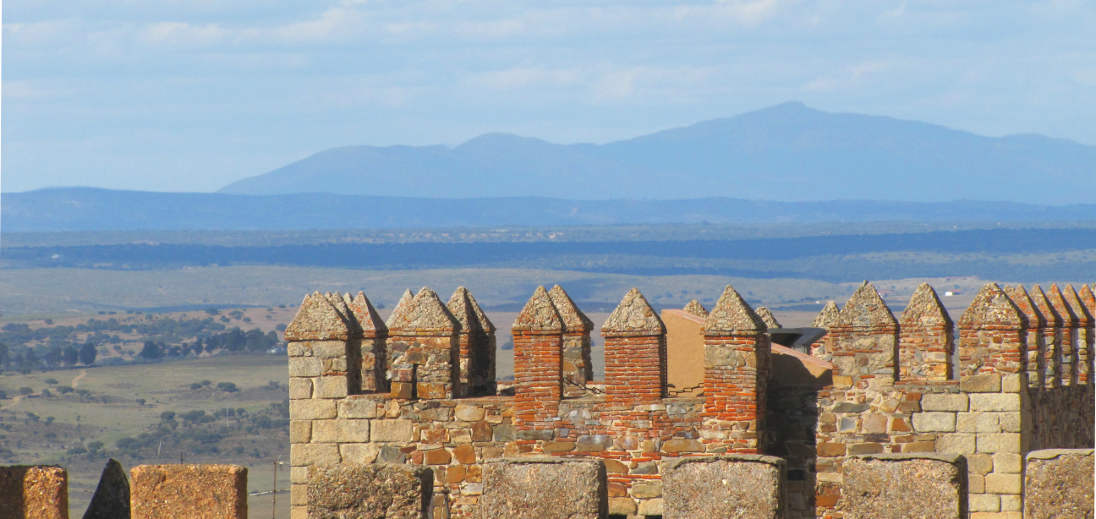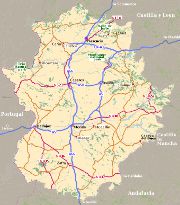About-Spain.net
- discover the real Spain
| On this page: | Caceres | Plasencia |
| Merida | Trujillo | Other sites |
Historically
off the beaten track, Extramadura is a treasure
trove of historic places and natural environment
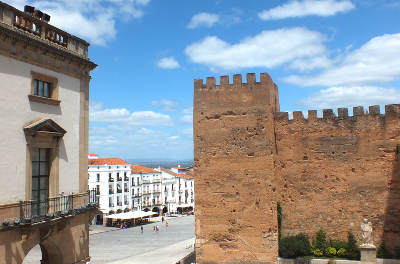
Cáceres, Plaza Mayor and Moorish Alcazar - a world heritage site
In Roman times, Extremadura was an important part of the Iberian peninsula. it lay astride the Via Delapidata, a major trade route for the commerce of tin and copper, that crossed Roman Iberia from the north coast to the south. Renamed Via de la Plata or Ruta de la Plata in mediaeval times, the route is today both a long-distance hiking route, and a vaguely defined tourist trail, running through Extremadura from north to south. The region is also crossed by the main route leading between Madrid and Lisbon.
With a population density of under 30 inhabitants per sq. km, Extremadura is one of the least populated areas of Spain - meaning that it has plenty of empty spaces and open countryside. It is also the poorest region in Spain, in terms of per capita GDP - a historic reality that is paradoxically one of the main reasons for the wealth of its historic heritage and natural environment today.
Merida and Roman Lusitania
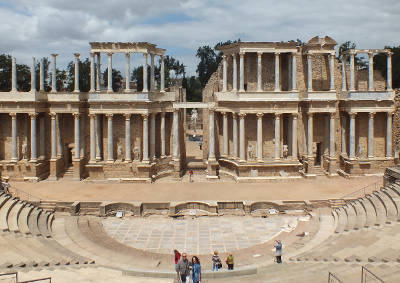
Mérida - the Roman theatre
Caceres
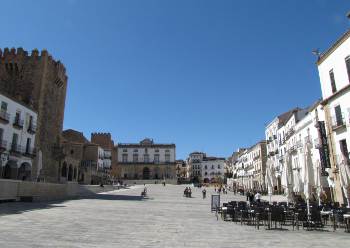
Plaza Mayor in Caceres - just outside the old city walls on the left
Plasencia
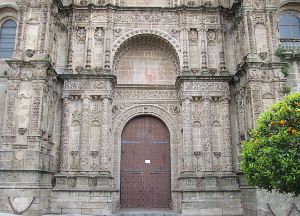
Platresque
doorway to Plasencia cathedral
.
Trujillo
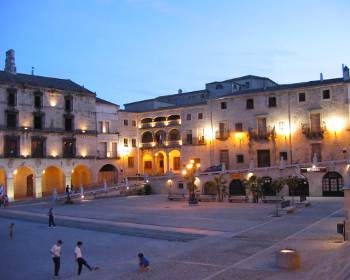
Trujillo's main square on a warm May evening
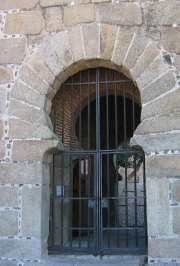
Other places, other sites
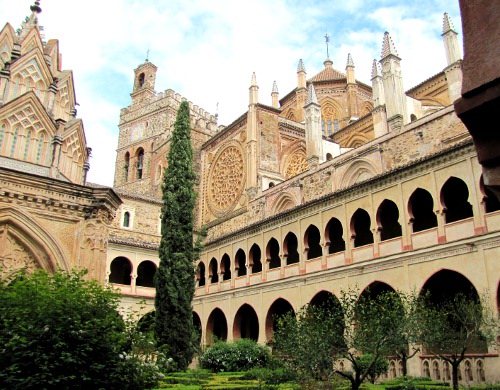
The
royal monastery at Guadalupe
On a smaller scale, the monastery of Yuste, on the southern slopes of the Sierra de Gredos, is a much smaller affair, a haven of peace and quiet where the great Hapsburg emperor Charles V - the contemporary of Henry VIII of England and François 1° of France - gave up the courts of Spain and the Netherlands, and came to live out the last two years of his life. The monastery lies close to the attractive small towns of the Vera , an agricultural area watered by streams from the mountains behind, and reputedly the home of the finest paprika in Spain.
Not far from Yuste, running northwest from Plasencia, is the Valle de Jerte, a popular place to visit in the Spring and early summer; the valley is the cherry capital of Spain, with millions of cherry trees planted on the slopes of the hills to either side.
For bird-watchers, the most interesting area of Extremadura is the Monfragüe national park, now classed as a Biosphere reserve; the park, north of Trujillo, includes a rocky and hilly area along part of the valley of the Tagus, and is renowned for its eagles and vultures.
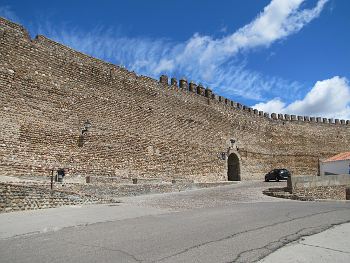
The remparts of Galisteo, and one of the town gates
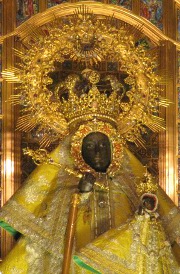
A short drive from Caceres, two other small towns deserve mention: to the south lies Montanchez, a hill town with a splendid castle, once a moorish stronghold, from whose ramparts there are spectacular views out over the plains to the north and the west. Northwest of Caceres is the small and sleepy town of Garovillas, with a remarkable colonnaded sixteenth-century town square; it is said that the plaza at Garovillas resembles countless similar town squares in small towns all over Latin America. And given that Extremadurans in the past formed a significant proportion of the Spaniards who settled in Latin America, there is probably some truth in this.
In the south of Extremadura, two small towns are well worth the visit. Half an hour east of Mérida, the town of Medellin, which was in 1485 the birthplace of the conquistador Hernán Cortés, lies at the foot of an impressive 14th century castle, defended by a double set of walls. The town also has a fine 17th century bridge over the river Guadiana, and - below the castle - a Roman theatre which has recently been excavated. Finally, in the far south of Extremadura, not far from the border with Andalucia, lies Zafra, a "white town" of Moorish origin, with a lovely arcaded Grand Plaza and a fine 15th century Alcázar which is now a Parador hotel. The Candelaria church, one of serveral interesting churches in Zafra, has a retable by Zurbaran.
Continue to...
► Moorish Spain - Roman Spain - Castles in Spain
Other pages of interest : Travel in Spain - Food and eating in Spain
► You may also like : Undiscovered France
► Moorish Spain - Roman Spain - Castles in Spain
Other pages of interest : Travel in Spain - Food and eating in Spain
► You may also like : Undiscovered France
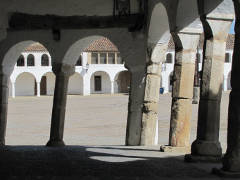
Small town - time stands still
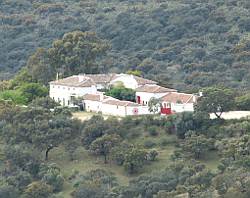
Finca
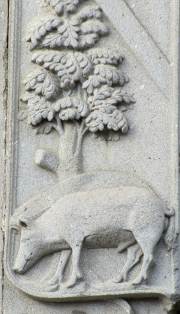 Fine
hams from pigs feeding on acorns made the fortune of some landowners in
the past
Fine
hams from pigs feeding on acorns made the fortune of some landowners in
the pastExtremadura
hotel finder :
hotel finder :
 For
the independent traveller, a choice of hotels and hostales in
Mérida, Caceres and Plasencia and their surrounding areas.
For
the independent traveller, a choice of hotels and hostales in
Mérida, Caceres and Plasencia and their surrounding areas.► Select city & star rating
for a broad choice of hotels and the best discounted online booking rates available.
| City | Budget hotels |
Quality hotels |
| Merida | 1-star | 3-star |
| 2-star | 4-star + | |
| Caceres | 1-star | 3-star |
| 2-star | 4-star + | |
| Plasencia | 1-star | 3-star |
| 2-star | 4-star |
More
places to stay
in Spain:
in Spain:
- Small hotels with character
Independent hotels
in Spain. - Gitelink Spain :
Rural holiday
cottages in Spain
| ►► Spain - a thematic guide: |
| Spain - the country Essential information about Spain. |
| Driving
in Spain Getting round Spain by car - roads and driving tips |
| Spain by train A guide to taking the train in Spain |
| Tourism
in Spain
Where to go and what to see |
| The coasts of spain |
| Top attractions in Spain |
| Andalucia |
| Eastern Andalucia |
| Western Andalucia |
| Asturias |
| Castile y Leon |
| Castile La Mancha |
| Extremadura |
| Valencia |
| Undiscovered Spain |
| Map of the Spanish regions |
| Accommodation
in Spain Where to stay, and the different options available |
| The
Spanish
way of life Spain is different; all you need to know about Spanish habits, including |
| Spanish food and eating |

Storks are everywhere during the warm seasons

